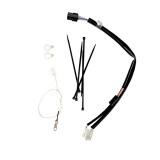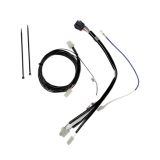
Index
1. Introduction
2. What is a boat thruster?
3. Brief thruster history
4. What are the different types of bow and stern thrusters?
5. Why do you need a bow and/or stern thruster system?
6. How to choose the right bow and stern thruster
7. Common problems with boat thrusters and how to avoid them
8. What kind of thruster upgrades are available?
9. What does it cost to install a bow or stern thruster?
10. What is the maintenance of a thruster?
11. Whom do I contact if I want a thruster for my boat?
Introduction
The product range of boat thrusters is now far more extensive than just a few years ago. Thus, it is essential to research thoroughly to understand which solutions will work best for your boat. In this guide for bow and stern thrusters, we give you in-depth information as well as what aspects to consider.
Choosing the best bow or stern thruster for your vessel is quite critical, as the thruster probably will accompany your boat for decades to come. Here we share our collective knowledge from more than 40 years of designing and manufacturing thruster systems for leisure and workboats. Our goal is to guide you towards the best possible thruster system for your vessel and your needs.
Here we will primarily address bow and stern thrusters with 12 and 24 VDC operating voltage. For AC electric and hydraulic bow and stern thrusters, you can download a dedicated pdf here →
We hope boat owners, boat brokers, boat manufacturers, and other interested parties will find our articles helpful and practically useful.
What is a boat thruster?
A boat thruster is a device that moves the boat in a sideways direction. Vessels fitted with both a stern and bow thruster has total 360 directional maneuverability. The most common type of boat thruster is a tunnel thruster installed in the bow or stern of a vessel with one or two propellers driven by an electric or hydraulic motor.

Brief thruster history
The relatively high costs of employing tugboats for every arrival and departure from port for commercial vessels were reasonably the main force behind the first thruster developments. Installing one or more thrusters on these massive ships made sense also surpassing the point of running cost reductions, as they increased the vessel's maneuverability and thereby increased safety in crowded waters.
In the mid-1980s, a few boat equipment manufacturers recognized the benefits that a bow thruster could provide for all boat types and sizes, and the development and production of the first thrusters for leisure boats hit the market.
For many years tunnel-based bow thrusters were open to the market; however, at that time, the products were considered to be relatively expensive accessories. But as average boat size increased steadily from year to year and the ports did not many boat builders now saw that such a docking aid offered tremendous support for boaters in the increasingly crowded and tight harbors.

What are the different types of bow and stern thrusters?
Today, there is a thruster for virtually any boat, regardless of hull type, material, or size from about 20 feet and upwards.
The most common thruster categories in the market today are:
- Thrusters installed in a tunnel
- Retractable thrusters
- External thrusters
The standard tunnel-based thruster is still the leading choice for most boat builders. Yet, due to a more mature market, requirements for installation flexibility and increased thrust-power has led to many redesigns, allowing for a well-functioning thruster solution for almost any vessel.
You can read more about the pros and cons of different thruster solutions here →
Why do you need a bow and/or stern thruster system?
Running your vessel in the open sea is a breeze, but come to a busy overcrowded or tricky harbor, and you may feel your blood pressure rise. As a mariner, you might have experienced that in these conditions maneuvering your vessel can be far more demanding than it seems.
Read more: Do I need a bow thruster on a small boat? →
Calculating wind, ocean current, tides, and other crafts' presence creates a chaotic three-dimensional dilemma in the brain, wishing you had the mind of an Apollo space astronaut. With one or more thrusters onboard, you gain one of the most critical factors to reduce stress while docking, which is time. Time to orient yourself, time to consider and plan, and time to wait for others!
Main benefits include:
- Better control under demanding conditions
- Less stress
- Lower risk of collision
- More attractive aftermarket value
- Being able to maneuver the boat on your own
Many boaters tend to have a lifelong relationship with the sea. Unfortunately, as age slowly takes its toll, handling your vessel becomes more difficult. But this is where a PRO thruster system can keep your passion for the sea thriving and well. With a bow and stern thruster with variable speed control onboard, you can pin the boat in the desired location and get alongside the dock and operate even a large vessel on your own the same way.

How to choose the right bow and stern thruster
Few boat owners will voluntarily accept the cost or labor to replace a pre-installed thruster, even if it does not perform as desired. So, picking the right thruster the first time is crucial for many years of operation after installation.
The most critical factors for choosing the right bow or stern thruster are:
- Sufficient thrust to cover your intended use with a good safety margin
- Location in the hull
- Adequate and sustained energy supply (battery voltage)
Read more: How much power do I need from my bow and stern thruster installations? →
The right thruster is energy efficient, quiet and powerful enough to help you in the worst possible conditions when the thruster is needed the most.

Common problems with boat thrusters and how to avoid them
From more than 40 years of designing and manufacturing thruster systems for leisure and workboats, we have experienced that boaters have two main struggles with their thrusters: insufficient thrust force and noise.
Sufficient power is paramount
A bow or stern thruster that cannot deliver adequate thrust when you get caught in windy conditions while docking when you genuinely need the assistance of a thruster to control the vessel is undoubtedly a poor investment.
There are three common reasons why a DC electric thruster may perform less than desired, whereas number one is considered most common:
- Too low power supply to the electric motor under load. A drop of only 1-2V can correspond to a significant loss of thrust.
- Obstruction to the flow of water through the tunnel from improper tunnel installation or hindrances.
- The thruster is not dimensioned correctly for the vessel's size from the beginning. Check if you can upgrade to a more powerful electric motor within the current tunnel diameter.
Noise
There is also a lot that you can do to reduce the noise produced by a thruster. The most important is to make sure the tunnel installation is optimal. - a thruster installation that screams throughout the harbor is, in fact, usually due to incorrect installation. To achieve an acceptable noise level, you should:
- Select the maximum possible diameter for the hull
- Check the tunnel openings have the correct geometry
- Install the tunnel deep enough not to suck air from the surface and through the tunnel
If you want a more massive heavy-duty bow or stern thruster, we recommend a speed controlled thruster. Under normal operating conditions, you will rarely need to run the thruster at full speed, which lowers the noise level significantly. Running the thruster at 50% load, for instance, will usually be close to undetectable.
Furthermore, it is essential to keep in mind that the bow of a boat may act as a speaker membrane when vibrations are applied. If you are very unlucky, the propeller will generate a frequency that resonates with the hull's natural frequency, which in turn creates a robust gain in noise. Traditional sound attenuation used in cars and the like can make a big difference. However, check that the material is suitable for marine use.
What kind of thruster upgrades are available?
For many vessels, there are several possibilities to upgrade or improve an existing installation.
Upgrade to PRO
Whom do I contact if I want a thruster system for my boat?
With nearly 50 years of R&D experience, we are dedicated to helping you understand your own needs and technical specifications to find the best thruster system for your boat.
Please see our dealer overview to find a local Sleipner representative who can guide you further in the process of securing a good solution for your boat.
If you did not find what you were looking for in this guide, you are welcome to send us an inquiry here. We wish you lots of great times at sea, and also in port!
What is the maintenance of a thruster?
A thruster will generally require little maintenance and have low operating costs after installation. If you follow the manufacturer's maintenance plan, which mostly involves regular cleaning, replacement of sacrificial anode, and general inspection, the thruster can for excellently for many, many years.

What does it cost to install a bow or stern thruster?
Typically, a thruster will represent a low proportion of the boat's total cost, especially when buying a new boat. For retrofitting, it is a bit more complicated, as it will vary considerably from boat to boat depending on how accessible the area for installation is and the running of cables.
Our best recommendation to obtain a decent understanding of the overall cost is to contact an experienced installer and ask for an actual offer based upon their experience from similar boats or by letting the installer do an inspection of your vessel.
A stern thruster installation would typically be an easier installation without the need to fiberglass work unless the thruster model is a retractable version.




